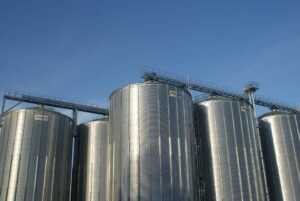
The Cabinet of Ministers of Ukraine has appointed Yuriy Sheiko as the first deputy energy minister, Cabinet spokesman Taras Melnychuk said.
“The Cabinet of Ministers of Ukraine appointed Yuriy Yevgenyevich Sheiko as the first Deputy Minister of Energy of Ukraine,” Melnychuk wrote in his Telegram channel following the government meeting on Friday.
Yuriy Sheiko is the acting First Vice-President – Technical Director, acting member of the Board of the joint-stock company NAEK “Energoatom”.

Ukrainians Liudmyla Luzan and Anastasiia Rybachok won a silver medal in the 500m canoe double sprint at the 2024 Olympic Games in Paris.
The athletes covered the distance in 1:54.30 minutes.
China took the first place in this event, and Canada came in third.

In January-July this year, Ukrainian mining companies increased exports of iron ore in physical terms by 2.15 times compared to the same period last year, to 20 million 803,661 thousand tons.
According to the statistics released by the State Customs Service on Friday, foreign exchange earnings from iron ore exports increased by 76.7% to $1 billion 831.314 million during this period.
Iron ore was exported mainly to China (36.88% of supplies in monetary terms), Slovakia (16.76%) and Poland (16.33%).
In January-July 2024, Ukraine imported iron ore for $208 thousand in the total volume of 771 tons, while in January-July 2023 it imported iron ore for $81 thousand in the total volume of 118 tons. Imports this year were carried out from the Netherlands (33.97%), Poland (30.62%) and Italy (17.22%).
As reported, in 2023, Ukraine decreased exports of iron ore in physical terms by 26% compared to 2022 – to 17 million 753.165 thousand tons, foreign exchange earnings from iron ore exports amounted to $1 billion 766.906 million (down 39.3%). Iron ore was exported mainly to Slovakia (28.39% of supplies in monetary terms), the Czech Republic (19.74%) and Poland (19.56%).
Last year, Ukraine imported iron ore worth $135 thousand in the total amount of 250 tons. During this period, imports were made from Norway (34.81%), Italy (28.89%) and the Netherlands (28.89%). While in 2022, iron ore was imported for $65 thousand in a total volume of 101 tons.

KMZ Industries (Karlivka Machine-Building Plant, KMZ, Poltava region) installed five elevator complexes in Cherkasy region in July 2024, the company’s press service reported on Facebook.
According to the report, in July, the construction and installation division of KMZ Industries simultaneously carried out work at all five facilities, including an elevator complex with a storage capacity of 30 thousand tons.
“We finished work at one site and immediately moved to another. This year is a very active season in Cherkasy region, where both farms and processing companies are expanding their storage capacities and upgrading elevator equipment. There is still a lot of work to be done,” said Ruslan Demchuk, regional representative of KMZ Industries.
KMZ Industries is the largest manufacturer of elevator equipment in Ukraine and produces a full range of equipment, including silos, grain dryers, transport equipment and separators, as well as provides automation and installation services. According to the company, it has sold more than 5,000 facilities. In 2012, the company acquired the assets of Brice-Baker (UK), one of the leading suppliers of elevator equipment in Europe, and in April 2021 announced a merger with the elevator business of Variant Agro Bud LLC.
According to the Clarity Project, in 2023, KMZ reduced its net profit by 3.9 times compared to 2022, to UAH 15.8 million, with revenue falling by 20% to UAH 650.2 million.
The plant ended the first quarter of this year with a net profit of UAH 35.4 million, up 3.9 times compared to January-March 2023, and revenue increased by 3.3% to UAH 71.7 million.
Dragon Capital Investments Limited (Cyprus), the ultimate beneficiary of which is Tomas Fiala, owns 80% of KMZ JSC shares, while Variant Agro Bud LLC owns 20%.

The Kingdom of Bahrain has opened access to its market for Ukrainian producers of poultry meat and poultry products, the press service of the State Service of Ukraine for Food Safety and Protection (SSUFSCP) reports.
“This week, the Ministry of Foreign Affairs, together with the State Service of Ukraine for Food Safety and Consumer Protection, is opening a new market for Ukrainian producers in the Kingdom of Bahrain. Last week we opened a new market in Bosnia and Herzegovina. The opening of two markets in a row in different regions of the world demonstrates the systematic work aimed at supporting Ukrainian exporters,” Foreign Minister Dmytro Kuleba said in a statement.
For his part, the head of the State Service of Ukraine for Food Safety and Consumer Protection, Serhiy Tkachuk, emphasized that the opening of two markets within a short period of time is the result of hard work that lasted for months and even years.
“The safety of Ukrainian products has already been highly appreciated in many countries around the world, and we are doing everything we can to increase the number of export opportunities for Ukrainian producers every day,” he added.
The State Service of Ukraine on Food Safety and Consumer Protection drew the attention of potential exporters to the need to comply with the requirements for the import of poultry meat and poultry products to the Kingdom of Bahrain. The relevant information is available on the website of the agency in the section “Requirements of the countries of the world” – “Background information on exports of the Kingdom of Bahrain”.
The health certificate for the export of poultry meat and poultry products to the Kingdom of Bahrain is published on the official website of the State Service of Ukraine on Food Safety and Consumer Protection in the section “International Cooperation” – “Veterinary and Safety” – “Certificates for Export from Ukraine”.

Farmers in all regions of Ukraine have harvested 30.640 million tons of new crops from 7.741 million hectares, the press service of the Ministry of Agrarian Policy and Food reported on Friday.
According to the report, more than 27.3 million tons of grains and 3.3 million tons of oilseeds have already been harvested.
It is specified that 20.494 million tons of wheat have been harvested from 4.732 million hectares at a yield of 42.2 c/ha, barley – 5.2 million tons from 1367.4 thousand hectares at a yield of 38.1 c/ha, peas – 457.7 thousand tons from 207.6 thousand hectares at a yield of 22.1 c/ha.
Ukraine continues harvesting oilseeds. In particular, more than 3.318 mln tons of rapeseed have been harvested from 1220.4 thou hectares with a yield of 27.2 c/ha and 0.3 thou tons of soybeans from 0.2 thou hectares with a yield of 15.2 c/ha.
At the same time, agrarians of Odesa region are the leaders in terms of grain harvesting, where 1072.9 thou hectares were threshed. Khmelnytsky region is the leader in terms of yield, with 65.1 c/ha.
Farmers in Dnipropetrovs’k, Odesa, Kharkiv and Kherson regions have started harvesting buckwheat and millet.
Harvesting of early grains and pulses has been completed in Ivano-Frankivsk, Vinnytsia, Kyiv, Poltava, Odesa, Kherson, Kirovograd and Cherkasy regions.